Female bodies are cyclical by nature, producing varying quantities of hormones at different points in our monthly menstrual cycle. These hormone fluctuations create four distinct phases of your cycle.
Learning about and embracing your internal cyclical nature is one of the most powerful and effective ways to maximize your true potential in all areas of life. Our periods don’t have to hold us back, even when we assume they will. It’s your unique cycle and you will need to learn to observe it, understand it, and work with it.
In this episode, I’ll be talking about The Four Phases of the Menstrual Cycle and what is happening on a hormonal level during each of these phases!
This episode is brought to you by Nutrisense, a provider of continuous glucose monitors. Visit Nutrisense.io and use my code NICOLE25 for $25 off your first month.
A Nutrisense CGM is an incredible way to monitor your blood sugar levels in real-time and their app helps you see exactly how your diet and lifestyle specifically affect your blood sugar. I tried a Nutrisense CGM this past summer and it was a game-changer. It was amazing to see how my meals and specific foods were affecting me positively or negatively. There was a whole lot of experimentation while using it to see what worked best for me and some foods were real shockers. Now you can get a Nutrisense CGM and take $25 off your first month of service. This includes two CGMs to be used for two weeks each, the app, and a month of free dietitian support. That support is invaluable and the best part of the service.
If you want to get your hands on a CGM, head to Nutrisense.io and use NICOLE25 for $25 off your first month.
Episode Details
Female bodies are cyclical by nature, producing varying quantities of hormones at different points in our monthly menstrual cycle—namely, estrogen, progesterone, and testosterone. Other hormones, such as follicle-stimulating hormone (FSH), luteinizing hormone (LH), anti-Müllerian hormone (AMH), prolactin, oxytocin, and cortisol; and neurotransmitters such as serotonin, epinephrine, and dopamine, also fluctuate. These hormone fluctuations create four rather distinct phases of your cycle.
In the beginning of 2019, the U.S. women’s soccer team was in its final phase of preparations for the upcoming World Cup in France. I know you’re probably wondering why I’m talking about this and what it has to do with the phases of the menstrual cycle, but hang tight. I’m getting to it.
At their training facility in Santa Barbara, California, players were put through a rigorous fitness regimen designed by Dawn Scott, the national team’s fitness coach. Scott had been the team’s fitness coach for nine years in the run-up to the 2019 World Cup, but this year she decided to do something different. In addition to her team of strength coaches and nutritionists, she added a new specialist: “period consultant” Dr. Georgie Bruinvels.
Bruinvels, a specialist in optimizing the performance of female athletes, had done extensive research into how each phase of the menstrual cycle impacts a woman’s athletic performance. By tracking each team member’s period, Scott and Bruinvels were able to gain a comprehensive understanding of her cycle and design strategies to maximize her performance during each phase. These strategies included adjustments to the sleeping schedules, diets, lifestyle, and training for each player. “It empowered them to be proactive,” said Bruinvels. “There’s no evidence that someone can’t perform to their best at any time in their cycle if they are proactive about taking steps.”
The U.S. team went on to win the 2019 World Cup, with Rose Lavelle scoring the winning goal in the finals. Rose got her period the next day.1 Amazing right? I mean, can you imagine having to play a world cup soccer game the day before your period?? I certainly can’t!
As the U.S. team’s story illustrates, learning about and embracing your internal cyclical nature is one of the most powerful and effective ways to maximize your true potential in all areas of life. That’s right. Our periods don’t have to hold us back, even when we assume they will. We women work hard to stay on top of everything we do, and we expect to have the same energy level every single day of every single month.
However, the cyclical nature of our bodies makes that impossible. Your hormones, particularly estrogen, progesterone, and testosterone, are meant to ebb and flow throughout the four phases of your menstrual cycle. As it cycles through the bleeding, follicular, ovulatory, and luteal phases, your body changes nearly every week— heck, sometimes every day. Just as each season brings its own distinct characteristics, such as the cold quiet of winter or the light-filled fecundity of spring, the hormonal shifts occurring in each phase of your cycle create different physical responses and emotions.
The hormonal changes occurring on an almost weekly basis throughout your cycle impact:
- your mood (whether you feel happy, sad, anxious, or calm);
- your sleeping habits;
- how you react to situations and people;
- the decisions you make;
- how social or introverted you are;
- your motivation and energy level;
- the nutrients you need most;
- the type of exercise that will best support you; and
- your libido.
I get into the nitty-gritty of these hormones in the book, but for now it’s enough to know that mastering your internal rhythms is the key to feeling more connected to your body and the first step to solving a lot of the physical and emotional complaints associated with your cycle. This knowledge will help prepare you for your own natural ebbs and flows and will provide important clues about whether your hormones are functioning the way they are supposed to in the various phases.
Phase 1: The Bleeding Phase (Menstruation)
You may have been taught that your menstrual cycle ends with your period, but actually, day 1 of your menstrual cycle is the first day of bleeding. On average, the bleeding phase lasts for 3 to 7 days. Right before your period, your progesterone level plunges, causing the breakdown and shedding of your uterine lining. As menstruation gets underway, your key female sex hormones, estrogen and progesterone, are at the lowest they will be in your entire cycle, with progesterone staying low until after ovulation.
When menstruation starts, the proverbial floodgates open, and you likely feel a sense of release and even relief after the anxiety or feelings of anticipation you felt leading up to it. During this week, you may feel tired, withdrawn, introspective, and emotionally vulnerable.
Your cervix, the cylindrical-shaped tissue that connects the vagina and uterus, changes position throughout your cycle. In this first phase, it is firm to the touch, sort of like the tip of your nose; in a low position; and slightly open to allow menstrual blood to pass through.
The bleeding phase also marks the first half of the follicular phase, during which a region of your brain known as the hypothalamus secretes gonadotropin-releasing hormone (GnRH), which instructs your pituitary gland (the “master endocrine gland”) to release follicle-stimulating hormone. This FSH communicates with your ovaries, and between days 1 and 4, it recruits a handful of ovarian follicles, each of which is a little balloon-like sac that contains a single egg. Between days 5 and 7, just as menstruation is wrapping up for most of us, one follicle from the selected group is chosen. It’s kind of like the Hunger Games of egg selection, because only one follicle is recruited to ovulate, while the rest of the follicles in the group will disintegrate. Mother Nature doesn’t play around!
Phase 2: The Follicular Phase
Next, we move into the non-menstruation half of the follicular phase, which is the time in the menstrual cycle when the ovaries continue preparing for the big O—ovulation, that is, not orgasm, but let’s hope you’re having orgasms during that time, too!
The maturing follicles produce estradiol in increasing amounts. Around day 8 of the menstrual cycle, or halfway through the follicular phase, that chosen follicle from the group starts to flex its muscles and dominate—thanks to the inhibitory effect of anti-Müllerian hormone on the others.12 As estradiol continues its ascent, it signals the brain to slow down FSH production and crank up luteinizing hormone production by the pituitary gland. Rising LH stimulates production of androstenedione and testosterone (male sex hormones), which play a supporting role in the act of ovulation.
As ovulation approaches, estrogen also prepares the uterus for pregnancy, thickening the blood vessels of the uterine lining. The cervix gradually moves higher in the vaginal canal and opens. Cervical fluid is pretty nonexistent the first few days after menstruation. Then, as estrogen builds and stimulates the cervix, cervical fluid begins to take on a wetter consistency, often looking pasty, creamy, or like lotion. You are most fertile in the second half of the follicular phase leading up to ovulation, and a barrier method of birth control should be used then if you are not planning to get pregnant.
Phase 3: The Ovulatory Phase
Contrary to popular belief, ovulation, not menstruation, is the star of the menstrual cycle show. As Dr. Lara Briden, author of Period Repair Manual, says, “Ovulation is how we make hormones.” The ovulatory phase is the shortest phase, but it’s the one that packs the biggest hormonal punch. It is the culmination of all the hard work your body has been doing throughout the follicular phase.
During this phase, estradiol levels rise in parallel to the size of the maturing dominant follicle. Increasingly high levels of estradiol tell the hypothalamus to trigger the mid-cycle LH surge that is needed to initiate ovulation. Then, right before the LH surge, the estradiol level falls, which is often the cause of mid-cycle/ovulatory spotting. LH and progesterone increase levels of prostaglandins and proteolytic enzymes, which are responsible for weakening the walls of the follicle, so the egg can more easily get out.
In a remarkably short period of time—the ovulatory process is only twenty-four to forty-eight hours long—this complicated dance of LH, FSH, estradiol, and progesterone results in an egg bursting out of the follicle on the ovarian surface and into the peritoneal cavity, where it is ushered into a fallopian tube by the fimbriae (finger- like projections on the tubes) and pushed along toward the uterus. Once an egg is released, it survives for twelve to twenty-four hours. (Within that window, another egg could be released. That second egg will also survive for twelve to twenty-four hours. If both are fertilized, this can result in fraternal twins.) The egg will either be fertilized on its journey through the fallopian tube by a sperm cell or it will disintegrate. The remainder of the follicle then becomes a temporary endocrine gland called the corpus luteum, which is an important player in the next and final phase.
Fun fact: ovulation occurs randomly from either ovary on any given cycle, but some studies have indicated that ovulation occurs more frequently from the right ovary and that ovulation on the right side has a higher potential for pregnancy.
At this point, your cervix becomes soft, moves up higher in the vaginal canal, and opens. This positioning helps your released egg get the best (strongest, healthiest) sperm, as those sperm will have to swim farther to get to the cervix, where they take a pitstop and then move on in their quest to reach the released egg.
In preparation for the sperm, your cervical fluid transforms into what is known as fertile-quality cervical fluid, becoming clear (aka translucent) and viscous (think raw egg white) and highly elastic or very wet and watery. When looked at under a microscope, the fluid will contain channels that help sperm swim up through the cervix. Fertile-quality cervical fluid nourishes the sperm, protects them from the vagina’s natural acidity, and guides them toward the egg.
Phase 4: The Luteal Phase
This phase typically ranges from 11 to 17 days but is about 12 to 14 days in most women. The length of the luteal phase is based entirely on how long the corpus luteum (the follicle that released the egg) maintains its progesterone production.
After ovulation, FSH and LH levels decline, with LH remaining low for the rest of the cycle and FSH rising slightly before menstruation to get the next round of follicles ready. Estrogen continues its sharp decline, while progesterone continues its climb thanks to the corpus luteum’s progesterone output. Progesterone will stay high throughout the luteal phase.
Progesterone is a thermogenic, or heat-inducing, hormone: it raises your basal body temperature for the remainder of the luteal phase. This rise in temperature is an important indicator of whether you’ve ovulated. Progesterone also further prepares the endometrium for a possible pregnancy. It transforms cervical fluid from stretchy and wet to opaque and sticky, or less fluidlike. If examined under a microscope, it would appear to have a basket-weave texture, which serves as your vagina’s very own sperm barrier. This is why it is referred to as infertile cervical fluid, as it’s particularly hard for sperm to swim through it at this stage.
During the second week of the luteal phase, estrogen makes one more appearance, in a last-ditch effort to further prep your body for pregnancy. Due to the higher estrogen, you may notice an increase in cervical fluid resembling that seen in the lead-up to ovulation. (Don’t worry, this is not fertile-quality cervical fluid, so you can’t get pregnant.) You might also find you’ve got increased energy, and a sex drive might blow in from nowhere. This is very exciting for those of us who struggle with PMS symptoms, as sex is often the last thing on our minds during this time!
Now, if you are trying to get pregnant and the egg is fertilized, it starts producing human chorionic gonadotropin (hCG) hormone and continues to make its way down the fallopian tube to the uterus. The hCG will signal the corpus luteum to keep making progesterone as well as estrogen, to support a pregnancy in its early stages.
If there is no pregnancy, the corpus luteum function begins to decline at about 9 to 11 days after ovulation.22 The drop in estrogen and progesterone that follows will tell the uterine lining it’s time to go. And you will start another cycle with the first day of your next period.
WOW! Aren’t our bodies remarkable ladies? Each month, your body is capable of making a mini endocrine gland in under twenty-four hours!) Yes, that corpus luteum is only 2-5cm long and it starts producing progesterone almost immediately after it is created. Men’s bodies do nothing like this!!! This is a testament to the incredible creative capacity of a woman’s body!
I mean, no juggler in the world could keep so many balls in the air at one time, which is why it’s easy to see how the slightest miscue could lead to a collapse of the entire endocrine system and the rise of period problems. But just because our cycles are intricate does not mean nurturing them has to be complicated. You don’t need to learn to juggle to have a healthy menstrual cycle; you just need to give it the support it needs and then pay attention to the amazing results.
I fully recognize that if your symptoms are a real slog, you might not be as excited about this hormonal juggling act as I am, but I encourage you to get my book to begin learning even more about your cycle so that you can begin to feel in control again.
Think about this question for a second. How do your hormones get messed up in the first place?
Here’s how: Low quality food, foods that cause blood sugar imbalances like refined carbohydrates and sugars, foods high in inflammatory omega 6 fatty acids like canola and corn oil, environmental toxins like BPA that mimic estrogen and phthalates that disrupt our thyroid hormones, a high level of stress in our lives that goes on unmitigated for long periods of time, and problems with our digestive system like low stomach acid, leaky gut, and gut dysbiosis aka a bacterial imbalance.
The key takeaway here is that the problem is actually the solution. A vast majority of us have control over most of these problems, meaning that we have the solution.
You can find all of this information and more in my book, Fix your period.
The book is FULL of explanations for everything, which I think most of you will appreciate. And it has a 6 week step by step protocol that walks you through food, blood sugar balancing, gut health reclamation, liver detoxification, addressing chronic overstimulation (AKA stress) and dealing with thyroid issues. Plus there is so much in there about what to do at the end of the 6-week program, the right tests to get depending on your symptoms or condition and how to live in harmony with the four phases of your cycle which I’ve just described in this episode. It’s 400 pages of menstruation education!!
When Dawn Scott and Dr. Bruinvels embarked on their plan to optimize their players’ training based on their cycles, before they could do anything, they first needed to understand the symptoms each player was exhibiting during each phase. Same goes for you. By recognizing these changes and living in sync with them, you can ensure that you’re always performing at your best. Remember, there is no one-size-fits-all approach to this. It’s your own unique cycle, and you will need to learn to observe it, understand it, and work with it.


